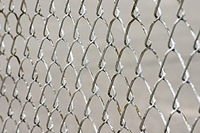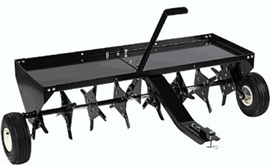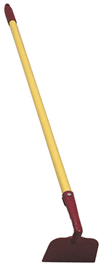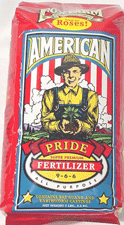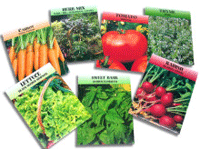DIY Frequently Asked Questions
Lawn and Garden Terms
Leverage-Assisted Trimmer
 Used for a variety of lawn and garden cutting applications.
Used for a variety of lawn and garden cutting applications.- Uses a cam located between the handles with an off-center pivot that increases the cutting efficiency.
- Reduces the effort required to squeeze the handles.
- Designed for one-handed use.
- Has a safety lock or catch to hold blades together while not in use.
Single-Bit Axe
 Most popular style of axe, the single-bit axe is used to fell, trim or prune trees, to split or cut wood.
Most popular style of axe, the single-bit axe is used to fell, trim or prune trees, to split or cut wood.- The easiest and safest axe for inexperienced woodcutters to use because it only has one cutting edge.
- The other end of the head, the poll, forms a hammer for driving wooden or plastic stakes. It should never be used to strike splitting wedges, steel posts, stone or any hard object.
- Handles for single-bit axes are curved to help increase leverage. Axe handles are made of hickory and range from 20″ to 36″ long. The most common is 36″.
- Common head patterns include Michigan, Dayton, Kentucky, Connecticut and New Jersey.
Double-Bit Axe
 Performs the same function as single-bit axe, but has two cutting edges—one on each end of the head.
Performs the same function as single-bit axe, but has two cutting edges—one on each end of the head.- Generally used by professional lumbermen.
- Double-bit axes have straight handles because the handle must be symmetrical with the double-edge head.
- Common head patterns include Western, Michigan, Swamping and Reversible.
Shingling Hatchet
 Generally used for installing wood shakes and shingles made of wood, fiberglass and composition.
Generally used for installing wood shakes and shingles made of wood, fiberglass and composition.- Some models have a replaceable adjustable gauge that helps installer determine the exposed length of a shingle.
- Many models also include nail slots and draw knives built into the head.
- Handles can be made of hickory, fiberglass, tubular steel or solid steel.
Lawn Fencing
 Offers homeowners inexpensive protection for shrubs, trees and flowerbeds.
Offers homeowners inexpensive protection for shrubs, trees and flowerbeds.- Vinyl-coated fence withstands harsh weather and does not need painting or other maintenance. Available in green or white.
- Plastic fence is available in a 2” square mesh design and a 1” diamond mesh.
- Available in white and green. Will not rot, rust or corrode and has no sharp edges.
- Galvanized fence is available in 2”x4” mesh.
- Typical fence stands 36” to 48” high.
Wire Fencing
 Wires are welded together.
Wires are welded together.- Can be taken down, rerolled and reused.
- Stronger than woven fencing.
- Used for fencing off children’s play areas, for protecting shrubs and young trees and for storing leaves for mulch.
- Available as galvanized or vinyl-coated in heavy 14-gauge 2”x1” or 12-1/2-gauge 4”x2” mesh.
- Typically sold in 50’ rolls, 36” or 48” high.
Garden Fencing
 Designed to keep small predatory animals out of the garden.
Designed to keep small predatory animals out of the garden.- A welded, galvanized fence with a large 4” square mesh at the top and a small 1” mesh extending 12” up form ground level.
- The lower mesh can be buried several inches below ground to prevent digging under the fence.
- Other specialty fencing is designed for use as a tomato cage, for protecting seedlings or as a flower trellis.
Vinyl Fencing
 Easy to install.
Easy to install.- Sturdy enough to withstand the elements and requires little maintenance.
- Fence posts can be made to slip over existing 4”x 4” posts. Boards and rails allow standard size limber to be inserted into them for added strength.
- Available in a variety of post and rail, picket and privacy design styles.
Gate Hardware
 A variety of latches, pulls, hinges and locking bolts are designed specifically for use on gates.
A variety of latches, pulls, hinges and locking bolts are designed specifically for use on gates.- Types of latches include sliding bolt locks, magnetic, thumb action or padlock.
- Hinges are usually reversible for use on left or right-swinging gates.
- They come in tee, strap and hook-and-strap configurations.
- Anti-sag kits are available that eliminate gate sag.
- Usually constructed of heavy-gauge steel or with a tough polymer housing that is rust-free.
- Ornamental hardware is often finished in black. Other types may be zinc-coated.
Tree Pruner
 Pruning shears or a pruning saw is attached to a long pole that will accept extensions or operates with a telescoping action.
Pruning shears or a pruning saw is attached to a long pole that will accept extensions or operates with a telescoping action.- Some models have a rope and pulley configuration where the user pulls the rope to instigate the cutting action.
- Typical pole length is 6 to 12 feet, but some reach up to 20’.
- Used for high work or where a ladder cannot be used.
Long Handle Round Point Shovel
 Round-tipped blade is made of steel and is forged or hot-formed to the front strap as a single unit.
Round-tipped blade is made of steel and is forged or hot-formed to the front strap as a single unit.- Has better cutting power than a square point shovel.
- Handle may be wood, fiberglass or metal.
- Best for digging, mulching or dirt removal.
- The top of the blade may have a turned lip called the foot pedal.
Scoop
 Has a deep blade for moving loose or bulky materials. Not recommended for digging.
Has a deep blade for moving loose or bulky materials. Not recommended for digging.- Most have a D handle but some may have a long handle.
- An aluminum scoop is light, durable and best for removing snow, grain or any loose material.
- A heavy-gauge steel scoop is the most durable and can be used for nearly any loose material.
- An ABS resin and poly scoop is designed for light duties such as snow.
Auger
 Used to burrow into soft ground to create holes for setting posts, footings or for planting trees or shrubs.
Used to burrow into soft ground to create holes for setting posts, footings or for planting trees or shrubs.- Some models have an adjustable yoke that can be locked into position or changed to drill different sized holes.
- Operates by turning in a downward motion.
- Has a T handle for easier turning.
- Common sizes are 6”, 8” and 10”.
Post Hole Digger
 Used to dig into the ground to create holes for setting posts, footings or for planting trees or shrubs in all soil types.
Used to dig into the ground to create holes for setting posts, footings or for planting trees or shrubs in all soil types.- The user plunges the tool into the ground with the handles together. The user then pulls the handles apart which brings the blades together to remove the soil.
- Heavy-duty models have sharp steel blades riveted to a heavy steel frame.
- Light-duty models are made with blade and handle socket rolled from one piece of metal.
- Typical spread point ranges from 5-1/2” to 6-1/4”.
Bow Head Garden Rake
 Rake head is attached to the handle with a long, curved bows extending from each end of the head.
Rake head is attached to the handle with a long, curved bows extending from each end of the head.- Handles are usually 48” to 54” long.
- Used to break up and smooth soil after it has been spaded and cultivated.
- Has sharp, curved steel teeth to pulverize dirt clods.
- The straight back is good for leveling the soil for planting.
Thatching Rake
 Used to remove thatch and dead grass from the lawn.
Used to remove thatch and dead grass from the lawn.- Pointed on one side for pulling and rounded on the other for pushing.
- The wheeled version rolls along the ground. It digs as it is pushed forward and cleans itself of debris as it is pulled backwards.
- The half-moon version does not have wheels. The user drags it along the ground. The pull stroke digs up the thatch, while the push stroke cleans.
Rubber-Vinyl Hose
 Combines the strength and durability of rubber with the lightness of vinyl.
Combines the strength and durability of rubber with the lightness of vinyl.- Easiest hose to use.
- Reinforced with tire cord fiber.
- The type with an expanded or foamed cover is easy to handle and has better kink resistance.
- The type with an extruded or non-foamed cover had good flexibility and has better abrasion resistance.
Vinyl Hose
 Most common type of hose and functions for most applications.
Most common type of hose and functions for most applications.- Reasonably priced.
- The most common size garden hose sold is 5/8” and 50’.
- The two-ply type is typically used as a promotional item and is susceptible to sun damage and deteriorates more rapidly than a rubber hose. It is lightweight and tends to kink easily.
- The non-reinforced vinyl type is adequate for “open service” only, which means it is suitable for use with rotary or oscillating sprinklers, but is not recommended for use with any accessory featuring an integrated shut-off valve.
Flat Hose
 Lies flat until water pressure rounds it into a 5/8” hose.
Lies flat until water pressure rounds it into a 5/8” hose.- Stores more easily and compactly than a conventional hose.
- Must be completely extended before water will pass through and completely drained before storing.
- Because it is drained after use, it is less susceptible to freezing and cracking and will not wear on edges.
- Weight is one-third that of a conventional hose but delivers same amount of water.
- One type is made with a polyurethane liner and a tightly woven polyester jacket. The liner is bonded to the jacket to reduce kinking and leaking. Another type has a construction similar to a conventional, reinforced vinyl hose.
Soaker Hose
 Uses thousands of tiny holes to allow water to seep out slowly over its entire length.
Uses thousands of tiny holes to allow water to seep out slowly over its entire length.- Saves water compared to sprinklers.
- May be made of canvas, vinyl, plastic or rubber.
- Can be run on top of the ground, under mulch or buried.
- If buried, wrap the end of the hose in plastic to prevent dirt clogging it.
- Generally, vinyl and rubber hoses are the most durable because they do not decay when buried.
Hose Reel
 Provides compact and efficient hose storage.
Provides compact and efficient hose storage.- Uses a rotary action to unroll and roll hose.
- Some models can be mounted on the house or garage, others ride on a caddy or cart.
- Usually incorporates a leader hose that attaches directly to the water supply.
- Some models feature storage trays for accessories.
- Typical capacity is 150’ for 5/8” hose. A large capacity reel basket holds 400’ for 5/8” hose.
- Some feature a screw-sliding guide mechanism for keeping the hose neatly wrapped on the reel.
Hose Mender
 Used to mend or connect hose.
Used to mend or connect hose.- Metal clincher couplings have metal cleats around a brass insert.
- Can be used on rubber or plastic hoses. To install, push the hose over the insert and pound down the cleats with a hammer or crimp with pliers to hold the hose.
- For plastic hoses, use a compression fitting with a threaded collar as it is less likely to puncture the outer covering.
- Plastic menders include a barbed tubular insert and clam shell-shaped clamps used on either plastic or rubber hose.
Hose Connector
 Used to link garden hose and watering devices to the home water source, to connect sections of hose and to provide linkage for sprinkling devices.
Used to link garden hose and watering devices to the home water source, to connect sections of hose and to provide linkage for sprinkling devices.- Usually made of plastic or brass.
- Some have a built-in shutoff valve.
- A Y connector is another type that attaches to the water supply to control two hoses at the same time.
Oscillating Sprinklers
 Sprays multiple streams of water out of openings in a spray tube that oscillates back and forth, watering a rectangular pattern.
Sprays multiple streams of water out of openings in a spray tube that oscillates back and forth, watering a rectangular pattern.- Used for watering medium to large areas.
- Traditional designs use curved aluminum tubes.
- Other designs use corrosion-free, molded straight tubes with jets set at progressive angles.
- Pattern adjustments are usually full sweep, left, right or center.
- Place more water at the end of the spray pattern than in the middle.
- Some models have built-in timers for automatic shutoff.
Impulse Sprinklers
 Also called pulsating sprinkler.
Also called pulsating sprinkler.- Will discharge more water in a given period and cover a greater area than other sprinklers.
- A spring-loaded arm provides a strong spray that is close to the ground, making it more wind resistant.
- A large orifice prevents clogging.
- A baffle plate controls the height of the stream to allow sprinkling under low tree branches.
- A diffuser pin adjusts water stream from full jet to fine mist.
- Also offers part- or full-circle operation.
Traveling Sprinkler
 Self-propelled sprinkler designed to cover large, irregular areas, some as large as 20,00 square feet.
Self-propelled sprinkler designed to cover large, irregular areas, some as large as 20,00 square feet.- One style is the wind-up type. It follows a cord laid out by a user, has two speeds and large hose capacities.
- Another style is the tractor type. It drags the hose behind as it follows the hose pattern. Better units are heavier, allowing a larger range, and have two speeds.
- Better models also have a shut-off valve.
- Delivers water by two arms similar to a rotary sprinkler. Adjusting these arms can change width of coverage.
Sprinkler Timer
 Attaches to a hose to control sprinkling.
Attaches to a hose to control sprinkling.- Can be either electronic or mechanical.
- User sets timer for the number of inches of water needed and turns off the sprinkler when the pre-set amount is reached.
- Some timers can be pre-set to operate for a certain amount of time, regardless of the amount of water discharged.
Underground Sprinkler
 Offers timed and pre-measured watering without hoses running through the yard.
Offers timed and pre-measured watering without hoses running through the yard.- A basic kit includes pipe and control tubing, valve assembly, sprinklers and electric control center.
- The safest and most convenient type is the automatic pop-up sprinkler. It can have adjustable spray, bubbler and fixed spray heads for specific watering tasks.
- Offers water savings as the sprinkler heads apply water at the rate of a gentle rain.
- Reduces water loss from erosive run-off. System is freeze-proof and can be winterized quickly.
- Sprinkler heads are mounted flush with the ground and out of the way of mowing equipment and children.
- Control center runs from any 110V outlet.
Drip Irrigation System
 Placed close to plant roots to water slowly and evenly.
Placed close to plant roots to water slowly and evenly.- Installed on top of the soil.
- The key fitting is the emitter or dripper head. It has a small orifice and fits on the end of the hose.
- Systems are easy to install and come with all of the necessary accessories such as hose adapters, couplings, emitters, spikes and clamps.
Lawn Cart
 Also called a utility cart.
Also called a utility cart.- Carries bulky material such as mulch, shrubs or fertilizer around the yard.
- Can be made of metal, poly plastic or wood and has two wheels.
- Has a V or hopper-shaped bottom and a front spout for easy dumping.
- Typical capacity is 3 to 4 cu. ft.
- Features may include deep tool trays to keep tools organized and tool clips on the side for hanging garden tools.
Planter’s Wagon
 Carries light loads of plants.
Carries light loads of plants.- Some features include a fold-down handle that converts into a seat, a side compartment for storing tools and gloves, a removable tray and the ability to convert to an upright workstation.
- Larger-capacity carts may be able to carry heavier loads than wheelbarrows but they are less maneuverable.
Wheelbarrow
 Light-duty models typically have a 3 to 4 cu. ft. capacity.
Light-duty models typically have a 3 to 4 cu. ft. capacity.- Medium-duty models typically have a 4 to 6 cu. ft. capacity.
- A rollbar in front of the wheel contacts the ground to make dumping heavy loads easier.
- Tray may be made of aluminum, steel or heavy plastic. Handles are either hardwood or metal.
- Features a semi-rounded front for easy dumping.
- Wheels may be solid rubber or pneumatic (inflatable). Inflatable tires are apt to puncture.
Contractor Wheelbarrow
 Typically has a 5 to 10 cu. ft. capacity.
Typically has a 5 to 10 cu. ft. capacity.- Tray has a deep front for added capacity and extra bracing.
- Legs and bracing are made from heavy-gauge steel.
- Wheel is typically 16” pneumatic.
- A wide rim bead around the trough adds reinforcement for heavy loads such as cement and bricks.
- Some models may offer knobby tires for added traction and longer wear.
Broadcast Spreader
 Also called a rotary spreader.
Also called a rotary spreader.- Quick, efficient way to spread seed, fertilizer, weed and pest control or ice melt.
- Has a hopper on a metal cart. The broadcast platform turns as the wheels move across the yard.
- Used for larger lawns.
- Feathers the spread of seed, eliminating sharply defined edges of spread.
- Best for use in lawns that do not have flower beds or gardens in the middle, since it spreads material in all directions.
- Includes flow setting to adjust for all sizes of seed and granules.
- Hopper capacity varies with model.
Drop Spreader
 Spreads precise seed and fertilizer spreading over smaller areas.
Spreads precise seed and fertilizer spreading over smaller areas.- Dispenses material with the pull of a lever.
- Takes longer than the broadcast spreader to complete a task, but offers more precision.
- Typically spreads in an 18” to 22” path.
- Includes flow settings to adjust for all sizes of seed and granules.
- Hopper capacity varies with model.
Handheld Spreader
 A handheld version of the broadcast spreader.
A handheld version of the broadcast spreader.- Used to spread small amounts of fertilizer, grass seed or ice melt.
- Since it does not have wheels, the spreader uses a hand-turned lever to spin the broadcast platform.
- Includes flow setting to adjust for all sizes of seed and granules.
- Hopper capacity varies with model.
Edging
 Sits close to the ground to separate flowerbeds from lawn areas and keep grass roots from spreading into flower and garden beds.
Sits close to the ground to separate flowerbeds from lawn areas and keep grass roots from spreading into flower and garden beds.- Typically constructed of polyethylene plastic, aluminum or galvanized steel with a rolled top edge.
- Another type is a length of scalloped wood slabs joined by wire in 3 ft. sections.
- Some types are designed to look like stone or brick but feature poly construction that won’t chip, crack or fade.
Plant Pot
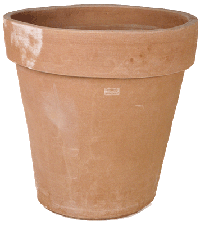 Also called planters.
Also called planters.- Comes in a variety of shapes and sizes, such as rectangular and round.
- Contains plants for hanging or displaying inside or outside the house.
- Clay pots are porous, allowing air and moisture to pass through.
- Plastic pots are lighter and more colorful, but depend on drainage holes to relieve excess moisture.
- Factors to consider when selecting a pot are size, drainage and construction.
- Pots often include a saucer to catch water from the drain holes.
Lawn Weed Control
 Weeds are classified as grassy (such as crabgrass), broadleaf (such as dandelions and plantain), annual or perennial.
Weeds are classified as grassy (such as crabgrass), broadleaf (such as dandelions and plantain), annual or perennial.- Weed seeds can lie dormant in the ground for several years, then grow again when conditions are right.
- Spring is the best time to control broadleaf and grassy weeds when they are small and vulnerable. Weed killers are formulated to work best in temperatures between 60°F and 85°F.
- Pre-emergent herbicides attack weeds before they break the surface of the soil. Apply them early in the spring. Post-emergent herbicides attack the plant after it begins to grow.
- Selective herbicides kill certain plants but do not harm others. Non-selective herbicides will kill all vegetation they touch.
- Do not rake or dethatch lawns after applying a pre-emergent herbicide. It will destroy the protective barrier the chemical has created.
Lawn Insect Control
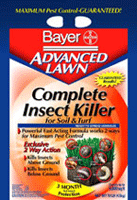 Controls a variety of insects that destroy healthy lawn turf.
Controls a variety of insects that destroy healthy lawn turf.- The active ingredient in some pesticides will remain active for months, eliminating the need for multiple applications.
- Some products can be sprayed on while others are incorporated into a fertilizer in granular form.
- Insects attacking lawns can be all shapes, colors and sizes, but they generally fall into two categories: surface-active (above ground) and soil active (below ground).
- Examples of surface-active bugs are webworms, cutworms, army worms andchinch bugs.
- Sod webworms damage lawns throughout the entire growing season by eating grass blades. Small moths flying in zigzag patterns across the lawn are a good indication these bugs are present.
- Chinch bugs damage lawns when temperatures rise above 80°F. They attack grass stems and suck out plant juices. Lawns usually have to be reseeded.
- Grubs are an example of soil active insects. They feed on grass roots, killing the grass in patches. White grubs become active when the soil warms up and they destroy lawns from late spring to early fall.
- Many insects do not pose problems to lawns. Before you decide to use a pesticide, determine that the number of pests and potential damage and environmental impact justify the use of a pesticide.
Lawn Disease Control
 Controls fungus-related diseases that destroy healthy lawn turf.
Controls fungus-related diseases that destroy healthy lawn turf.- Fungi adheres to the plant, steals food from and/or deposits toxic substances in the cells of the plant.
- Some types of disease controls are granular chemicals while others are liquids.
- Homeowners who use a mixture of grasses have a better chance of their lawn surviving a disease as most diseases attack one specific type of grass.
- Common types of lawn fungi are snow mold, leaf spot and dollar spot.
- Snow Mold attacks grass any time from late fall to early spring. Grass turns a reddish color or tan to gray. It can destroy small areas or complete lawns.
- Leaf Spot results in brown or black spots on leaves and can occur through a wet, cool fall, winter and spring season. Thinning of the lawn may not be noticeable, but leaf activity is quite pronounced.
- Dollar Spot starts in mid-spring and/or when weather is moist and cool. Damaged spots are a bleached straw color. A cobweb-like growth is a sign the fungus is active.
Household Pesticides
 Kill or repel pests that could come inside the home.
Kill or repel pests that could come inside the home.- Improper application can have harmful effects on families and pets.
- One popular type is the spray or fogger. These penetrate the cracks and crevices inside the house where insects nest. Users will need to leave the house for a period of time while the chemical works.
- When using foggers, read the warning labels regarding use around open flames. The pilot lights on gas furnaces and appliances will ignite the insecticide if it reaches a high enough concentration in the home.
- Pest repellents keep insects and rodents from entering the home. Common examples are sprays that repel dogs and wild animals from gardens and flowerbeds, or spray-on mosquito repellents that can be used on skin or clothing.
- Pest traps will kill or confine rodents or insects. Common examples are the mousetrap and the roach trap. Traps incorporate some type of bait.
- Poisons are ingested directly into the pest. Keep in mind they can also be harmful to household pets or small children.
- Be sure to read the pesticide package carefully and follow all instructions.
Sphagnum Peat Moss
 Adds body to sandy soil to help with water retention and also loosens and aerates densely packed soil with high clay content.
Adds body to sandy soil to help with water retention and also loosens and aerates densely packed soil with high clay content.- Consists of the remains of a spongy type of northern moss called sphagnum.
- Reduces leaching of soil nutrients.
- Adds organic material to soil.
- Available in compressed bales from 6 cu. ft. down to 1 cu. ft.
- Also available in smaller packages for use in flowerpots and in planter boxes that must be soaked before using.
Reed-Sedge Peat
 Also known as Michigan-type peat.
Also known as Michigan-type peat.- Has similar characteristics and soil benefits to Sphangnum Peat Moss.
- Includes the remains of a variety of swamp plants such as sedge grasses and reeds.
- A velvety dark brown product that does not need extensive soaking.
- Available in 25- and 50-lb. bags as well as smaller quantities.
- Not a plant food. Fertilizers must still be added.
Compost Bin
 A bin used to make compost.
A bin used to make compost.- Comes in a variety of sizes and shapes. Should use at least a 27 cu. ft. in size to ensure it retains enough heat to spur the compost development.
- Compost is the process of converting waste material into a type of synthetic manure.
- Compost may contain leaves, grass clippings, prunings, straw, spoiled hay, coffee grounds, eggshells, paper and wood ash that decompose through bacterial action.
- Due to its fertilizing value, compost can be spread on the lawn in the fall or on the garden at any time during the growing season.
Organic Mulch
 A ground cover that protects ground temperature, reduces evaporation, prevents erosion, controls weeds, attracts earthworms and enriches the soil.
A ground cover that protects ground temperature, reduces evaporation, prevents erosion, controls weeds, attracts earthworms and enriches the soil.- Good mulch should allow water to pass through it quickly but not be easily washed away by the rain.
- Keeps soil surface as much as 10° cooler than exposed soil.
- Thick applications of mulch will stop weeds, but it will need to be refreshed every year.
- Types include bark, pine nuggets, cypress, hardwood, peat moss and pine mulch.
Rubber Mulch
 Made from non-toxic, environmentally friendly, recycled materials that can be used indoors or outdoors.
Made from non-toxic, environmentally friendly, recycled materials that can be used indoors or outdoors.- Like organic mulch, it inhibits weed growth while retaining soil moisture.
- Natural shape allows airflow into the ground.
- Looks like organic mulch but doesn’t rot, dissolve into the ground, wash away from rain or loose its color as easily as regular mulch.
- Available in a variety of colors.
Landscape Fabric
 A type of ground cover used to prevent weeds from growing while allowing moisture to penetrate.
A type of ground cover used to prevent weeds from growing while allowing moisture to penetrate.- User cuts holes in fabric to enable plants to grow.
- Usually covered with mulch or decorative stone when used in landscaped areas.
- Can be used on newly seeded lawns to prevent seeds from blowing or washing away and to spur germination.
- Can be organic or synthetic, woven or unwoven.
- Available in various colors.
- Sizes range from 3’ to 6’ wide to 15’ and 50’ long.
Natural Organic Fertilizer
 One of three common types of fertilizer, the other two are inorganic and synthetic organic.
One of three common types of fertilizer, the other two are inorganic and synthetic organic.- Does not dissolve in water.
- Converted to usable forms by microorganisms in the soil.
- Helps to create proper physical growing conditions, but can add disease or weeds to the lawn.
- Usually does not contain a complete mix of the essential nutrients, making it necessary to apply additional types of fertilizer.
- Less concentrated than synthetic fertilizer.
- Slow-acting release.
Synthetic Organic Fertilizer
 Contains ureafoam and methylene urea.
Contains ureafoam and methylene urea.- Provides a combination of slow and fast release of nitrogen, combining the best of the other two kinds of fertilizer, inorganic and organic.
- Easier to use than organic fertilizers because they are typically packaged for use with a specific application and are less bulky.
Liquid Fertilizer
 Spreads with a hose that attaches to a container holding the fertilizer. Other types may be used on plants and mixed in a watering can.
Spreads with a hose that attaches to a container holding the fertilizer. Other types may be used on plants and mixed in a watering can.- Fertilizer is in a concentrated form that is diluted with the water from the hose.
- Nutrients are immediately available to the plants, which makes this the fastest response fertilizer.
- May require user to fertilizer more frequently, since fertilizer is absorbed quickly.
- Fertilizer must be spread evenly to avoid burning.
Kentucky Bluegrass
 Forms a good sod when grown alone and thrives when included in a mixture.
Forms a good sod when grown alone and thrives when included in a mixture.- Slow to germinate and become established.
- Does not tolerate dense shade.
- Responds well to fertilization and high mowing.
- Grows well in lawns in the cool-climate, Northern half of the U.S., except in areas with mild winters, such as the maritime Pacific Northwest.
Weed Trimmer
 Used for trimming weeds where lawn mowers cannot reach.
Used for trimming weeds where lawn mowers cannot reach.- Comes in electric and gas-powered versions.
- Some gasoline models have a two-cycle engine, which uses a blend of two-cycle oil and gasoline in the gas tank. Gasoline models with a four-cycle engine do not require mixed gasoline.
- D-handles are usually adjustable and allow for left- or right-handed use.
- A strong monofilament nylon line serves as the cutting blade. Cutting path is typically 17”.
- Straight shaft trimmers allow for easy trimming under shrubs and branches. Curved shaft trimmers are easier for trimming along sidewalks, etc.
- Some models have a head that can twist and convert the tool into an edger.
Hedge Trimmer
 Typically comes in electric or cordless models.
Typically comes in electric or cordless models.- Uses two, double-sided reciprocating blades to trim shrubs and hedges. Some models may have single-sided blades.
- Better models have vibration reduction features that ease the strain on the user.
- Blade lengths can range from 20” to 30”.
- Other features include two large ergonomic handles, a blade guard, a throttle starting lock that prevents accidental engagement of the blade and start/stop controls on the handle.
Edger
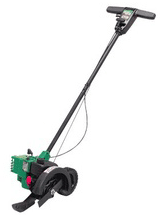 Available in gas-powered or electric versions.
Available in gas-powered or electric versions.- A wheel rolls along the ground as a guide while an adjustable blade edges sidewalks and trims around trees.
- Some models feature padded handles and a vibration reduction system to reduce the strain on the user.
- Other features include a skid plate to protect the blade gearbox, a debris deflector on the blade and a start/stop control on the handle.
Chain Saw
 Usually gasoline powered, but electric and cordless models are also available.
Usually gasoline powered, but electric and cordless models are also available.- Has an endless chain of cutting teeth that moves at high engine speeds.
- For cutting and trimming trees and shrubs.
- Blades sizes typically range from 12” to 36” long.
- Engines are typically two-cycle, requiring a blend of oil and gas.
- Standard features on many models include chain brakes forincreased operator safety, a blade guard and automatic oilers.
- Other features may include carrying cases and large, cushioned anti-vibration handles to reduce the strain on the user.
Leaf Blower
 Also called blowers.
Also called blowers.- Uses a high-powered fan to clear the yard, driveway, deck, etc, of leaves and debris.
- Most common model is hand-held, although some are wheeled.
- Some models can be converted into a vacuum that collects leaves and debris into a bag.
- Some vacuum models will turn leaves into mulch.
- Available in gasoline and cordless models.
- Gasoline models are typically two-cycle.
Garden Tiller
 Used to loosen and till the ground to prepare it for planting.
Used to loosen and till the ground to prepare it for planting.- Also used to turn under lawns that are being repaired.
- Gasoline engine drives the wheels as well as blades called tines used to break the soil. Wheel action and tine action is controlled separately.
- Some models have tines that operate with a counter-rotating action.
- Others use a forward rotating action, which is more common.
- Till paths from 14” to 20” wide, depending on the size of the tiller and 6” or 8” deep.
- The rear-tine tiller is used for larger gardens and its weight helps get the job done with little effort from the user. The engine is usually 4 to 8 hp and up and sits in front of the tine. These tillers are heavy and large, but best for heavy-duty work.
- The front-tine tiller works well for mid-sized areas and some confined spaces, although it can be difficult to maneuver. The engine is usually 3 to 5 hp. It is tough and affordably priced.
- Tillers with two-cycle engines are lightweight, easy to handle, especially in tight spaces, and are easy to maintain. They are good for cultivating established flowerbeds and gardens.
- Most tillers have forward and reverse speeds as well as depth adjustments. Some models have attachments that allow for different types of soil preparation.
- Possible features include a bumper to protect the engine and electric start.
Lawn Mower
 Usually gasoline powered. Electric and cordless models are available for smaller lawns.
Usually gasoline powered. Electric and cordless models are available for smaller lawns.- Cuts grass with a flat blade that rotates at the speed of the engine.
- The self-propelled type has an operator-controlled, wheel-drive engagement handle to control forward power.
- The side-discharge type discharges grass clippings to the right side of the mowing path.
- The rear-discharge type discharges grass clippings to the rear of the mowing path.
- Available with an attachable lawn bag to gather lawn clippings.
- The mulching type is designed to cut and recut grass clippings into fine particles that will fall back, unseen, into the turf.
Lawn Tractor
 The riding mower, or lawn tractor, cuts grass, but some types can also tow garden carts.
The riding mower, or lawn tractor, cuts grass, but some types can also tow garden carts.- Engines may be 13 to 25 hp.
- Heavy-duty garden tractors have the additional ability to use ground-engaging implements such as tillers, plows, snow throwers, etc.
- Some models have two or three side-by-side blades that widen the cutting path. Cutting widths can be as wide as 50”.
- Features may include automatic transmission, cruise control, reverse cutting, adjustable deck heights, the ability to turn on a tight radius, an hours meter and a cast iron front axle.
Snow Blower
 Gasoline or electric powered.
Gasoline or electric powered.- A single-stage blower uses a rotating, rubber tipped auger to pick up snow from driveways and sidewalks and throw it either forward or through a chute in a single motion.
- Do not use a single-stage blower on gravel driveways, as the blower could pick up and sling stones.
- A two-stage blower can be used on gravel and is best for large areas or deep snow. This blower operates by first picking up snow with a slow turning metal auger, then slinging it out a chute from a fast-spinning impeller. These types are usually self-propelled.
- Desirable features include easy chute and deflector adjustment, headlights and folding handles for easy storage.
- Choose the model based on the typical amount of snow in your area. For areas with 12” to 18” of snow, recommend a two-stage model with 7 to 9 hp. For areas with moderate accumulations, recommend a 5.5 to 8 hp machine. For a smooth surfaces and light snowfall, recommend a single-stage blower.
- Clearing paths for two-stage blowers range from 21” to 31”.
Guttering
 Aluminum is the most popular type of guttering and used on most homes today.
Aluminum is the most popular type of guttering and used on most homes today.- Galvanized guttering is sturdy, but is unpainted and requires some type of finish. This type must also be cleaned regularly if it is to last.
- Vinyl guttering is easy to install and is manufactured specifically with the do-it-yourselfer in mind.
- Plastic guttering is the least expensive option but not very durable.
- Prolonged cold and hot weather can cause plastic guttering to be damaged.
- K-style is the most popular, while a half-round style is also available.
- Popular sizes of gutters are 4”, 5” and 6”. Larger sizes may be available.
- Available in a variety of colors.
- Uses a variety of fittings and connectors.
- Continuous guttering is popular and avoids joints in the gutter, but is usually installed by a professional.
Downspout
 Attaches to the gutter to carry water down the side of the house.
Attaches to the gutter to carry water down the side of the house.- Rainfall capacity of a guttering system is largely dependent on the size and number of downspouts rather than strictly gutter size.
- Downspouts are usually rectangular in shape and come in 10’ lengths.
- Popular sizes of downspouts are 2”x3”, 3”x4” and 4”x5”.
Cooking Grate

Cooking grates are used in grills. This is what the food is placed on so that it doesn’t fall into the fire/burners. Some grills have multiple shelving options for food that needs to be close to or away from the heat.
Extension Ladder
- A non-self supporting type of ladder with two similar sections that are linked with internal guides on the bottom of base section and external guides on the top.
- Sections are pulled apart to increase length.
- Used for working in high areas and primarily for exterior applications.
- Available in heights ranging from 16’ to 40’.
- Smaller extension ladders are extended manually and secured with gravity spring lock brackets
- that rest on the selected rung.
- Larger extension ladders are extended by means of a rope and pulley running down the side of the ladder and secured with a cleat.
- Generally available in all aluminum and fiberglass with aluminum rungs.
- Rungs can be round or flat and are usually serrated for enhanced slip resistance.
- Ladder shoes pivot to allow full contact with ground. Shoes can also be turned up to penetrate soft ground for extra stability.
- Quality classifications include consumer (household), commercial (mechanic) and industrial grades.






